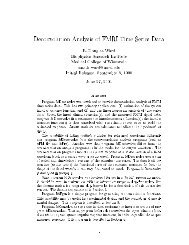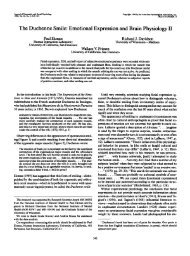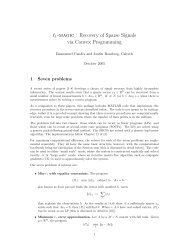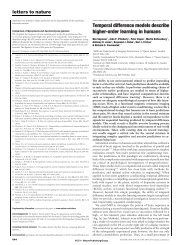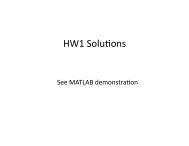Neural correlates of attentional expertise in long-term meditation ...
Neural correlates of attentional expertise in long-term meditation ...
Neural correlates of attentional expertise in long-term meditation ...
Create successful ePaper yourself
Turn your PDF publications into a flip-book with our unique Google optimized e-Paper software.
Table 1. Meditation block data: Bra<strong>in</strong> regions differentially activated for EMs vs. NMs<br />
ROI<br />
Volume,<br />
mm 3<br />
Talairach<br />
coord<strong>in</strong>ates,<br />
x, y, and z<br />
EM<br />
t value<br />
NM<br />
t value<br />
EM vs. NM<br />
t value<br />
EM hours<br />
partial r value<br />
EMs NMs<br />
Frontal<br />
Left MFG/IFG, BA45, 46 1,355 49, 29, 19 4.4** 0.77 3.2*** 0.72**<br />
Right SFG, BA9 1,009 31, 42, 31 2.9** 0.02 2.4* 0.47<br />
Left supplementary motor area, MFG, DLPFC, BA9, BA32 924 21, 6, 50 3.3** 1.0 2.5* 0.63*<br />
Left rectal gyrus, BA11 811 0.5, 43, 26 3.8*** 1.9 3.4*** 0.32<br />
Left precentral, DLPFC, BA6 1,535 34, 2, 36 4.2*** 1.3 3.0** 0.72**<br />
Parietal/posterior<br />
Left IPS, superior parietal, supramarg<strong>in</strong>al gyrus, BA7 7,400 24, 61, 46 3.6*** -.46 3.2*** 0.71**<br />
Right superior parietal, BA7 1,359 14, 62, 54 4.8*** 1.3 3.8*** 0.62*<br />
Occipital/temporal<br />
Right cuneus, BA17 1,792 22, 85, 11 3.7*** 1.6 4*** 0.52<br />
Left middle temporal gyrus, IFG, BA20, BA21 1,938 38, 7, 26 4*** 3.2*** 5.1*** 0.53<br />
Right middle temporal gyrus, BA21, BA22 786 54, 12, 8 1.7 2.7* 3.2*** 0.63*<br />
Fusiform, BA37 3,272 42, 55, 16 4.5*** 0.16 3.5*** 0.61*<br />
Noncortical<br />
Left putamen 808 30, 20, 3 3.9*** 0.83 2.8** 0.61*<br />
Right lentiform, parahippocampus, BA28 2,989 29, 42, 11 4.0*** 0.41 2.9** 0.60<br />
Cerebellum, declive, culmen 22,082 4, 56, 14 4.4*** 0.27 3.3*** 0.68*<br />
Left cerebellar tonsil 1,944 22, 39, 40 4.0*** 0.33 3.3*** 0.67*<br />
NM EM<br />
Left medial front/Acc, BA6, BA32 941 10, 39, 26 1.4 2.2* 2.5* 0.32<br />
Right Ins, BA13 851 39, 13, 15 2.2* 2.1 3.0** 0.21<br />
Data are from a t test subtraction (significantly different between groups at P 0.05 corrected). *, P 0.05; **, P 0.01; ***, P 0.005.<br />
susta<strong>in</strong>ed activation over time compared with LHEMs and also<br />
showed a delay <strong>in</strong> the amount <strong>of</strong> time it took to reach maximum<br />
activation <strong>in</strong> these regions, typically 10–20 sec <strong>long</strong>er. These results<br />
are presented for the DLPFC ROI <strong>in</strong> Fig. 1F. All groups had<br />
significant (NMs and LHEMs) or near significant (INM and<br />
MHEMs; P 0.06) activation <strong>in</strong> the first 10 sec <strong>of</strong> the <strong>meditation</strong><br />
block (LHEMs significantly greater than all other groups). However,<br />
for the last 80 sec <strong>of</strong> the block, there was an <strong>in</strong>verted u-shaped<br />
curve <strong>in</strong> which activation for NM INM LHEM MHEM (all<br />
groups significantly different from each other; P 0.001). However,<br />
whether these activation differences are due to skill learn<strong>in</strong>g<br />
or strategy and task performance differences cannot be def<strong>in</strong>itely<br />
resolved <strong>in</strong> this study.<br />
Because MHEMs may have been able to reach a less effortful<br />
tranquil <strong>meditation</strong> state with<strong>in</strong> these short blocks, it is possible that<br />
regions that rema<strong>in</strong>ed active <strong>in</strong> the latter part (last 80 sec) <strong>of</strong> the<br />
<strong>meditation</strong> block for the MHEMs may be the m<strong>in</strong>imal bra<strong>in</strong> regions<br />
necessary to susta<strong>in</strong> attention on a visual object.<br />
Distract<strong>in</strong>g Sound Data. In addition to look<strong>in</strong>g at the bra<strong>in</strong> regions<br />
<strong>in</strong>volved <strong>in</strong> generat<strong>in</strong>g and susta<strong>in</strong><strong>in</strong>g the <strong>meditation</strong> state, we<br />
exam<strong>in</strong>ed event-related neural responses dur<strong>in</strong>g presentation <strong>of</strong><br />
distract<strong>in</strong>g sounds, presented at 2-sec <strong>in</strong>tervals dur<strong>in</strong>g the last<br />
two-thirds <strong>of</strong> the Med. and Rest blocks. These sounds could be<br />
neutral (restaurant ambiance), positive (baby coo<strong>in</strong>g), or negative<br />
(woman scream<strong>in</strong>g) and were contrasted with randomly presented<br />
silent, null events with the same tim<strong>in</strong>g. In this paradigm, 13 EMs,<br />
13 NMs, and 10 INMs were <strong>in</strong>cluded (see Methods). General<br />
auditory process<strong>in</strong>g pathways (temporal cortex and Ins) were<br />
commonly activated for all participant groups <strong>in</strong> response to<br />
distract<strong>in</strong>g sounds dur<strong>in</strong>g both states (data not shown). A state<br />
ANOVA (sounds <strong>in</strong> Med. vs. Rest) revealed that participants<br />
showed an overall ‘‘active response’’ (no suppressed regions) <strong>in</strong><br />
response to the sounds <strong>in</strong> Med., <strong>in</strong>volv<strong>in</strong>g regions such as right<br />
<strong>in</strong>traparietal lobule/temporal parietal junction, bilateral pre- and<br />
post-central sulci, DLPFC, Ins, and anterior SFG (see SI Table 5 for<br />
state effects for all three groups; also see SI Fig. 5 A–C).<br />
Next we looked for differences between the groups. Our hypothesis<br />
predicted that NMs would be more distracted by the sounds and<br />
thus would show more activation <strong>in</strong> default-mode regions related to<br />
task-irrelevant thoughts and <strong>in</strong> emotion regions. First, NMs did not<br />
have any regions that were more active than either the EMs or<br />
INMs [SI Fig. 5C vs. A and B; see also state-by-group (EM vs. NM)<br />
ANOVA <strong>in</strong> SI Table 6]. These reduced differences for NMs may<br />
have been due to the greater similarity between Med. and Rest<br />
states for these participants, as we saw <strong>in</strong> the Med. block data.<br />
NEUROSCIENCE<br />
Table 2. Meditation block data: Regions differentially activated for EMs vs. INMs<br />
ROI<br />
Volume,<br />
mm 3<br />
Talairach<br />
coord<strong>in</strong>ates,<br />
x, y, and z<br />
EM<br />
t value<br />
INM<br />
t value<br />
EM vs.<br />
INM t<br />
value<br />
EM hours<br />
partial r value<br />
EM INM<br />
Left anterior MFG 854 26, 43, 7 2.85* 1.94 3.17** 0.20<br />
INM EM<br />
Left IFG/anterior superior temporal gyrus 1,135 36, 12, 16 1.70 2.91* 3.40** 0.21<br />
Superior P. central/BA4 † 495 34, 26, 59 1.72 4.59** 4.56*** 0.05<br />
LO/medial occipital † 464 39, 62, 3 4.04** 6.32*** 3.41** 0.27<br />
Right P. Ins † 406 40, 33, 18 0.84 6.80*** 3.83** 0.15<br />
Data are from a t test subtraction (significantly different between groups at P 0.05 corrected; smaller clusters marked with †).<br />
*, P 0.05; **, P 0.01; ***, P 0.005.<br />
Brefczynski-Lewis et al. PNAS July 3, 2007 vol. 104 no. 27 11485



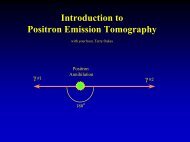
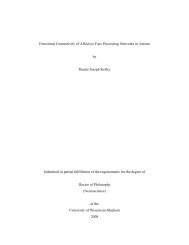
![[F-18]-L-DOPA PET scan shows loss of dopaminergic neurons](https://img.yumpu.com/41721684/1/190x146/f-18-l-dopa-pet-scan-shows-loss-of-dopaminergic-neurons.jpg?quality=85)
